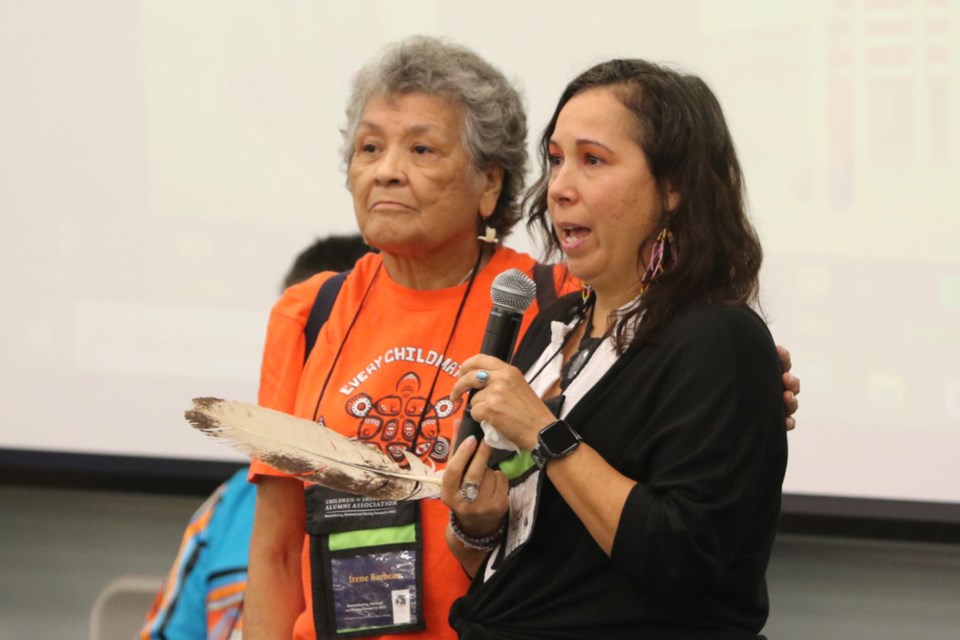A group representing residential school survivors and their families has made the decision not to disturb any human remains found at the site of the former Shingwauk Indian Residential School, which now serves as the campus of Algoma University.
In a presentation made during a gathering for Shingwauk survivors over the weekend, Children of Shingwauk Alumni Association (CSAA) President Irene Barbeau said a consensus among survivors was reached during a meeting intended to establish protocols around the search for unmarked burials that was hosted by the organization in Sault Ste. Marie this past December.
“What I heard consistently by other elders from Kamloops was that they said the Indigenous way when somebody passes away, you bury them where they died — if they died in a bush, you do not disturb the grave,” Barbeau said during the presentation.
Children of Shingwauk began planning for its own search of the former residential school site in Sault Ste. Marie days after Tk'emlups te Secwepemc First Nation announced the discovery of 215 suspected unmarked graves at the former Kamloops Indian Residential School with the use of ground-penetrating radar.
Barbeau, a member of Fort Albany First Nation who attended Shingwauk from 1958 to 1961, asked survivors for suggestions on how to memorialize any unmarked graves should any be identified during the site search.
“We know we’re not going to dig anything when it’s found, but the next step that we haven’t quite decided yet is how do we memorialize that piece of property where something is there,” she said.
Dr. Paulette Steeves, a Tier II Canada Research Chair Healing and Reconciliation and professor at Algoma University, used her background in archaeology to assist in the site search.
“She has vast knowledge in that realm, and with that knowledge — which is the non-Indigeous way — she still had information that we needed in order to approach this in a good way,” said Jay Jones, past president for CSAA and former site search coordinator. “You need both sides of the fence there. You need that knowledge to move forward, because you have to satisfy both sides — there [are] legalities involved that you have to be careful with, otherwise it could just put a wrench in the works and you’d be stalled for a long time.”
Steeves in turn helped secure the services of SNC-Lavalin, a Montreal-based engineering company which agreed to perform the ground-penetrating radar search pro bono.
“At that time, we had no funding whatsoever to do this search. But CSAA knew we had to start this as soon as possible,” Jones said.
Jones told survivors and family members during the presentation that he devoted hundreds of hours, while working as a designer for General Motors in Michigan, to kick off the search between June and September of last year. He would later take leave from his job at GM and temporarily relocate to Sault Ste. Marie for a period of six months in order to lead the search.
His parents, the late Vernon and Susie Jones of Walpole Island First Nation, were survivors of Shingwauk Indian Residential School. Jones' uncle, Leo Kicknosway, also attended the school and is buried in Shingwauk Cemetery.
“I didn’t even think about how huge the project was, how emotional that project was, how many hurdles I would have to jump over, but I wouldn’t trade that time that I spent up here for anything else on the planet,” he said.
The first leg of the site search was completed in December 2021 and has yet to resume. CSAA says it is still awaiting the results of the initial search efforts, which were anticipated by the end of June.
“We were trying to track it down before this gathering,” Barbeau said.
The Children of Shingwauk also used part of its presentation at the survivors gathering to introduce new Waa-Naadmaaged Site Search Manager Sarah Blackwell, a member of Aundeck Omni Kaning First Nation on Manitoulin Island, who began working for the group last month.
Blackwell says facilitators will be hired by Children of Shingwauk in order to engage the 85 communities where survivors of Shingwauk originated from.
“We will hear from each of you,” she said. “We will have these regional discussions, regional stories where survivors will have an opportunity to speak and share and help guide us on this site search, because we need your stories. We need your memories.”
Blackwell was clutching an eagle feather gifted to her by elder Jake Pine as she spoke to survivors and family members.
“I intend to carry this feather with me through all the work that we do, that we’re going to do through this site search,” she said.
A separate search for unmarked burials at the Shingwauk Cemetery will be carried out by Garden River First Nation with the blessing of the Shingwauk Education Trust, an organization which holds much of the land and financial assets of the former Shingwauk Indian Residential School.
More information about the site search can be found on the Children of Shingwauk Alumni Association website.
